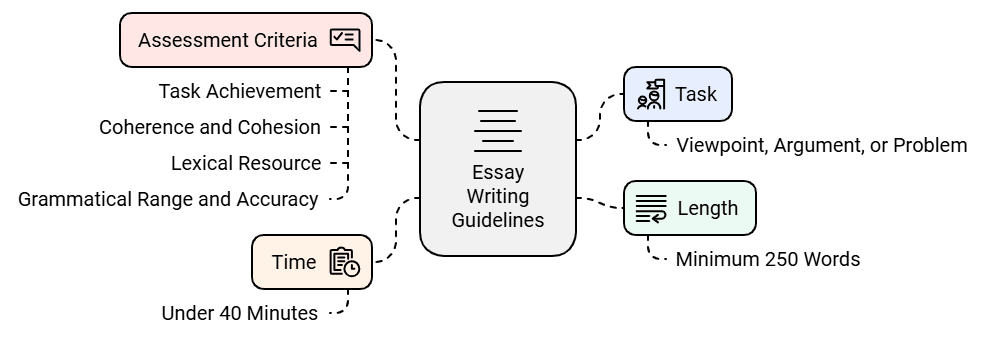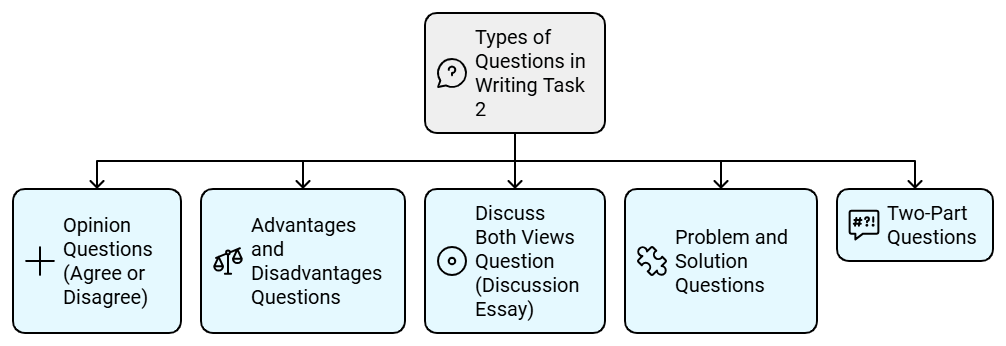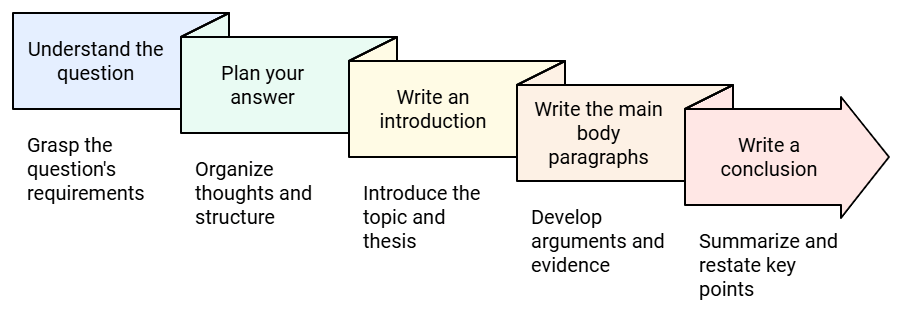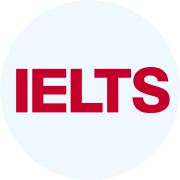How to Attempt the Writing Task 2 | Writing for Academic IELTS PDF Download
What is IELTS Writing Task 2?
IELTS Writing Task 2 is a part of the IELTS exam that evaluates your essay writing skills in response to a specific topic.

- Task: You will be given a viewpoint, argument, or problem, and you need to write an essay addressing it.
- Length: Your essay should be a minimum of 250 words.
- Time: Aim to finish your essay in under 40 minutes.
- Assessment Criteria: You will be judged on Task Achievement, Coherence and Cohesion, Lexical Resource, and Grammatical Range and Accuracy.
- Importance: Task 2 accounts for two-thirds of your total score in the Writing test.
Types of Questions in Writing Task 2

1. Opinion Questions (Agree or Disagree)
These are sometimes called ‘agree or disagree’ or ‘argumentative’ essays and are one of the most common types of IELTS Task 2 question. The first part of the question will be a statement. You will then be asked to give your own opinion about the statement. Here is some typical wording that might be used:
- What is your opinion?
- Do you agree or disagree?
- To what extent do you agree or disagree?
- Direct question.
Example Question
Some people believe that unpaid community service should be compulsory in high school programmes (for example, working for a charity, improving the neighbourhood or teaching sports to younger children). Do you agree or disagree?
Sample Answer
It is argued that volunteering should be made part of the school curriculum. This essay agrees with that suggestion completely because it help pupils develop soft skills and helps them gain much-needed work experience.
Education should not be limited to strictly academic pursuits, and those in education should also develop life skills, such as teamwork, empathy and self-discipline, and one of the best ways to hone these aptitudes is through community service. Serving those less fortunate than ourselves teaches us many lessons, including how to work with people from other backgrounds and the value of hard work, thus enabling us to hone these skills before becoming an adult. For example, many young people from wealthier countries take a gap year and help those less fortunate than themselves to increase their gratitude for what they have and improve their work ethic.
Many colleges and companies are also increasingly looking for this type of experience. Most school leavers have the same grades, and charitable work can help set you apart from other students when making college applications. For example, Cambridge and Oxford receive thousands of applications from straight-A students yearly and can only accept a small percentage of applicants. What you have done outside the classroom often differentiates you from everyone else and gets you that coveted spot.
In conclusion, teenagers should be made to partake in unpaid work as part of their schooling because it will help them learn things they wouldn’t ordinarily learn from their teachers, and it will also boost their chances of getting into third-level education.
2. Advantages and Disadvantages Questions
The first part of the question will be a statement. You will be asked to write about boththe advantages and disadvantages of the idea stated.Example Question
Technology is being used more and more in education. Discuss the advantages and disadvantages.
Sample Answer
It is argued that technology plays an ever-increasing role in schools and universities. Increased access to information and student freedom are the main advantages, whereas dependency on technology and decreasing levels of face-to-face contact are the main disadvantages.
Access to more information and student autonomy are the principal advantages of increasing the use of electronic devices in education. With the internet, students can access all the information available about any topic, regardless of what books and other resources are available in the school. Furthermore, students can focus on whatever topic or subject they want and study it in depth. A prime example of this is the number of online university courses available to students, covering a myriad of subjects that, up until recently, were unavailable to most learners. This has resulted in more people studying third-level degrees than ever before at a pace and schedule that suits them.
The main disadvantages associated with the increasing use of technology in education are the dependency on this technology and the decrease in face-to-face interaction between students. With many students now using the internet as their primary source of information, they often struggle to use other academic resources to find what they’re looking for. As well as this, students spend more time looking at computer screens by themselves than interacting with each other, which is thought to lead to lower levels of emotional intelligence. For instance, the recent explosion in smartphone use has been at the expense of genuine human interaction. This results in soft skills, such as verbal communication and empathy, being affected.
In conclusion, the benefits technology brings to education, such as unrestricted access to information and student autonomy, must be weighed against the drawbacks, such as dependency on this technology and the negative effects on human interaction.
3. Discuss Both Views Question (Discussion Essay)
In discussion essays, you have to discuss both sides of an argument. Usually, you will be asked for your own opinion as well. The easiest way to approach this type of IELTS Task 2 question is to choose one point of view to agree with and one side to disagree with.
Example Question
Technology is being used more and more in education. Some people say that this is a positive trend, while others argue that it is leading to negative consequences. Discuss both sides of this argument and then give your own opinion.
Sample Answer
There is an ever-increasing use of technology, such as tablets and laptops, in the classroom. It is often argued that this is a positive development, whilst others disagree and think it will lead to adverse ramifications. This essay agrees that an increase in technology is beneficial to students and teachers.
The Internet has provided students with access to more information than ever before. This has allowed learners to research and learn about any subject at the touch of a button. It is therefore agreed that technology is a very worthwhile tool for education. Wikipedia is a prime example, where students can type in any keyword and gain access to in-depth knowledge quickly and easily.
However, many disagree and feel that technology deprives people of real human interaction. Human interaction teaches people valuable skills such as discourse, debate and empathy. Without these soft skills, many people find it difficult to become successful in work and their personal lives. Despite this, human interaction is still possible through the internet, and this essay disagrees that technology should be dismissed for this reason. For instance, Skype and Facebook allow people to interact in ways that were never before possible.
While the benefits of technology, particularly the internet, allow students to tap into limitless sources of information, some still feel that people should be wary of this new phenomenon and not allow it to curb face-to-face interaction. However, as long as we carefully consider the importance of human interaction in education, the educational benefits are clearly positive.
4. Problem and Solution Questions
Example Question
Students are becoming more and more reliant on technology. What are some of the problems associated with reliance on computers, and what are some of the possible solutions?
Sample Answer
Learners are becoming increasingly dependent on technology, such as the Internet and mobile devices. This essay believes the main problems associated with dependence on computers are the lack of original thought and copying original work from others and suggests critical thinking classes and writing analysis software as the most viable solutions.
The principal problems with over-reliance on technology are people being unable to think for themselves and plagiarism. With access to so much information, students often rely on other people’s opinions instead of forming their own. As well as this, they often use search engines to answer a question and copy the text from a website rather than thinking about the question. This practice is prohibited in schools and universities and stunts students’ intellectual development because they will never truly think for themselves, which is what university is supposed to be for. For example, many teachers complain that students copy web pages straight from Wikipedia word for word rather than giving a reasoned answer to their questions.
Solutions to these worrying problems are special classes to focus on critical thinking and teachers using anti-plagiarism software to detect copying. If teachers create situations where students have to infer meaning and express opinions based on a small amount of information, this will ensure that students have an opportunity to develop these skills. Also, if students know that their assignments are being checked for plagiarism, this will be enough to deter them from doing so. For instance, many universities already use this kind of software to scan coursework for plagiarism, and it could be extended to include all homework by learners in both secondary and tertiary education.
In conclusion, the main problems with the overuse of technology in education are the lack of original thought and plagiarism. These can be solved through special classes that teach students analytical skills and plagiarism detection software.
5. Two-Part Questions
Example Question
As most people spend a major part of their adult life at work, job satisfaction is an important element of individual wellbeing. What factor contributes to job satisfaction? How realistic is the expectation of job satisfaction for all workers?
Sample Answer
As most adults spend most of their time at work, being content with your career is a crucial part of a person’s health and happiness. This essay will first suggest fair pay as a key element leading to job satisfaction, and it will then state that it is not very likely that everyone can be happy with their job.
The most important thing that satisfies someone at work is being compensated fairly. If those more senior than you respect you as a person and the job you are doing, then you feel like you are valued. A fair salary and benefits are important marks of respect, and if you feel you are being underpaid, you will either resent your bosses or look for another job. These two factors came top of a recent job satisfaction survey conducted by Monster.com, which found that 72% of people were pleased with their current role if their superiors regularly told them they were appreciated.
With regard to the question of happiness for all workers, I think this is and always will be highly unlikely. The vast majority of people fail to reach their goals and end up working in a post they don’t really care about in return for a salary. This money is just enough to pay their living expenses which often means they are trapped in a cycle of disenchantment. For example, The Times recently reported that 89% of office workers would leave their jobs if they did not need the money.
In conclusion, being satisfied with your trade or profession is an important part of one’s well-being, and respect from one’s colleagues and fair pay can improve your level of happiness; however, job satisfaction for all workers is an unrealistic prospect.
How to Answer IELTS Writing Task 2 Question?

Tip 1: Understand the question
You must understand the question before you attempt to answer it. This way, you’ll know exactly what the examiner is looking for. One of the biggest mistakes students make is not answering the question fully, which stops them from getting a score higher than a Band 5.
To analyse the question, you must first identify the question type, then identify the keywords in the question and finally identify the instructions words. This will help you understand exactly what the examiner wants you to do with the question.
Tip 2: Plan your answer
The students who get the highest marks in Writing Task 2 always plan their answers for up to 10 minutes. Planning helps you organise your ideas and structure your essay before you write it, saving you time and helping you produce a clear and coherent essay.
Tip 3: Write an introduction
The introduction should answer the question directly. This tells the examiner that you know what you are doing straight away and helps you write your main body paragraphs.
Tip 4: Write the main body paragraphs
This is where you give the examiner more detail. You do this by stating your main points and supporting these with explanations and relevant examples.
Tip 5. Write a conclusion
In your conclusion, you should provide a summary of what you already said in the rest of your essay.
|
30 videos|206 docs|17 tests
|
FAQs on How to Attempt the Writing Task 2 - Writing for Academic IELTS
| 1. What is the structure of an IELTS Writing Task 2 essay? |  |
| 2. How much time should I spend on IELTS Writing Task 2? |  |
| 3. What types of questions can I expect in IELTS Writing Task 2? |  |
| 4. How can I improve my score in IELTS Writing Task 2? |  |
| 5. Is it important to include examples in my IELTS Writing Task 2 essay? |  |
















